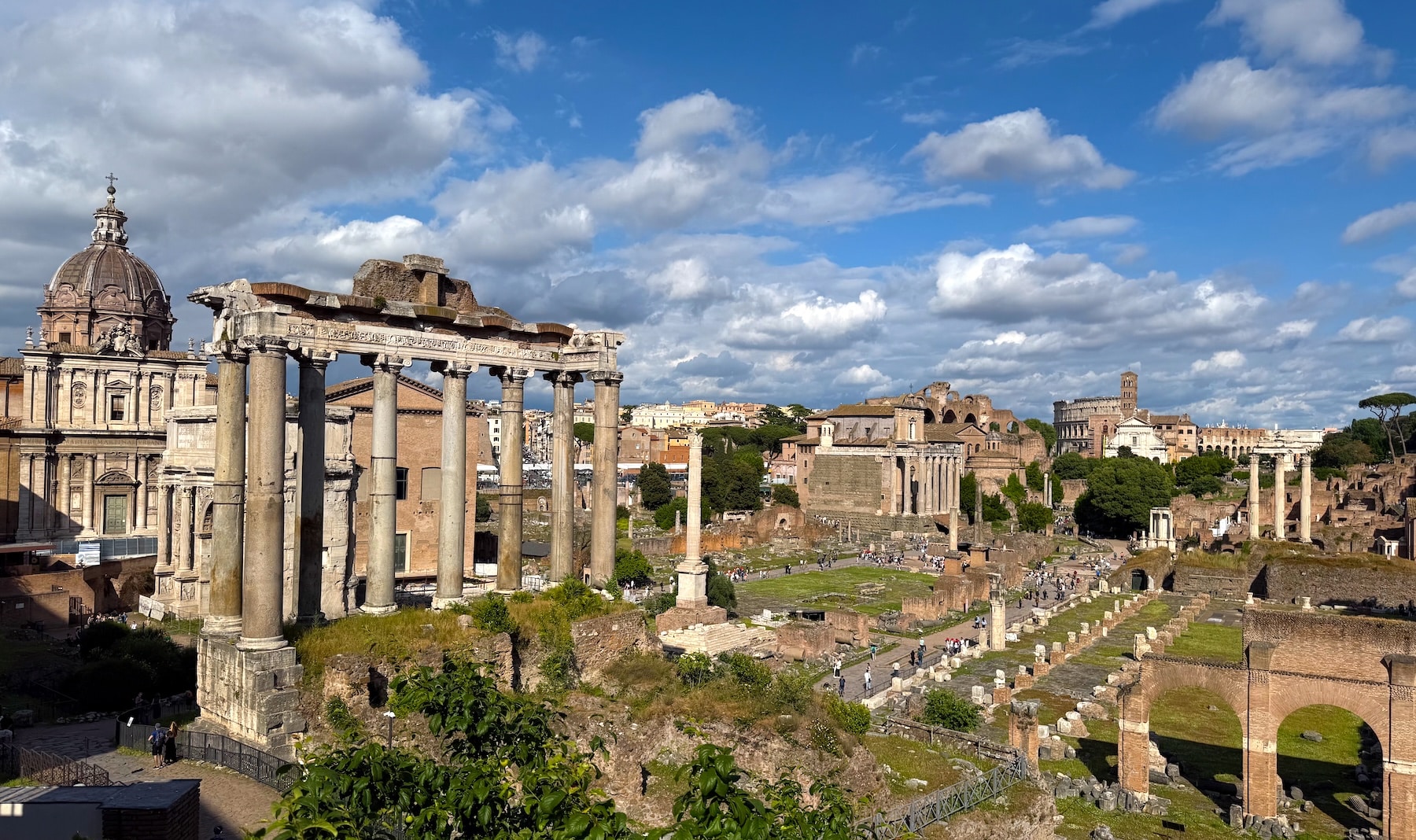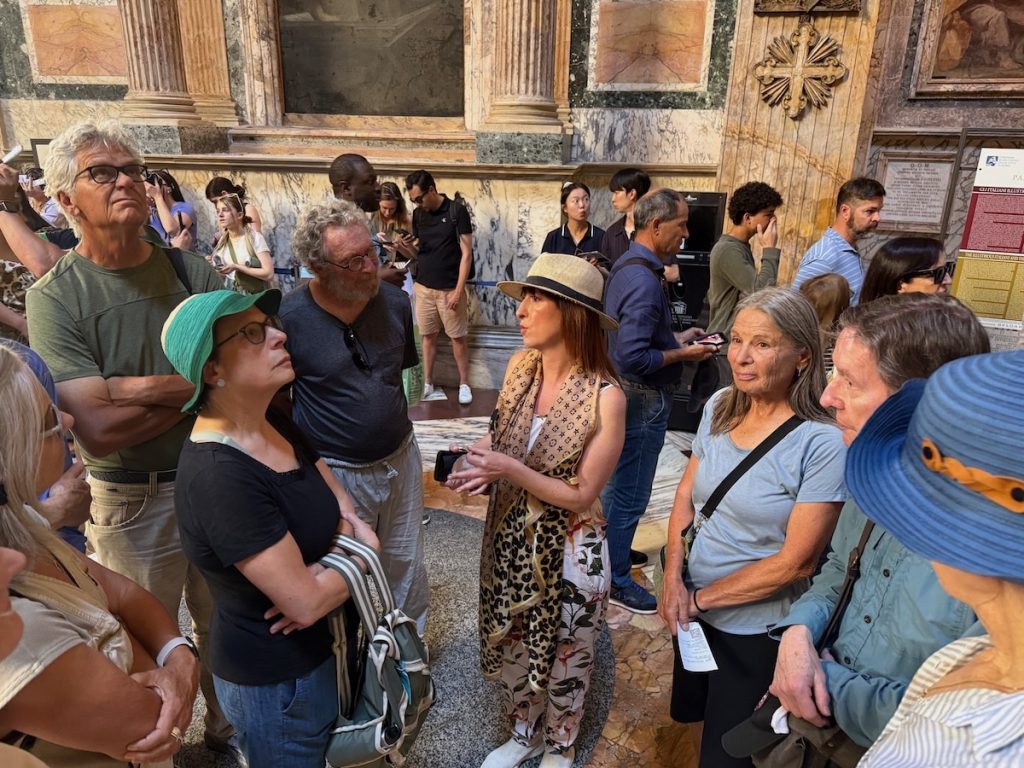
Undiscovered Rome: small group tour
Small group tour of Undiscovered Rome
Most visitors come to Rome seeking the familiar: the Colosseum, St. Peter’s, the Spanish Steps. Yet behind these landmarks lies another Rome: quiet, contemplative, and endlessly revealing. This itinerary is a week-long immersion in that other city: of ancient roads, Renaissance villas and Etruscan tombs. Our Undiscovered Rome tour is designed for travellers who may already have visited the Vatican and the Roman Forum and who are now wanting something different.
- Roman Villas at Tivoli
- Underground Rome
- Airport transfers, meals & transfers included in the price
- Dozens of 5 star reviews from past guests
- 15 years of experience in running tours in Italy
Tour Features
- Rome off the beaten track
- Maximum group size is 12 guests (minimum 6).
- Guaranteed departure dates
- UNESCO World heritage sites
- Accompanied by a Tour manager throughout your journey
- Tour cost includes entrance fees to main sites/museums
- Private 17-seater minibus
- Tour cost includes all hotel city taxes
- The Pantheon
- Villa Farnesina
- Villa Adriana and Villa d’Este at Tivoli
- Etruscan tombs at Cervetri
- The Via Appia
- Aqueducts and Underground Rome
- 7 nights in a charming hotel in the centre of Rome
- All lunches/breakfast
- 5 evening meals with drinks (2 evenings not included)
- Arrival/Departure airport for this tour: Rome Fiumicino airport
- Transfers and pick-ups/drop-offs from/to the main airport of arrival on the day of arrival/departure of the tour are included
- Some walking involved – you should be able to walk 5 kilometres without difficulty.
Full Itinerary
Day 1
Arrival, The Aventine Hill & Santa Sabina
Airport arrival and transfer to the hotel.
After arrival and settling in, we take a short walk on the Aventine Hill, one of the seven hills of ancient Rome.
We visit the church of Santa Sabina: the oldest extant ecclesiastical basilica in Rome: built on the site of early Imperial houses, it dates from the 5th century AD. Then, just behind Santa Sabina, we take a stroll in the Giardino degli Aranci, a small park with one of the finest views of Rome’s skyline.
And finally, we take a peek through the Keyhole of the Knights of Malta for a perfectly framed view of the Dome of St. Peter’s.
Evening meal and overnight in Rome.
Day 2
The Pantheon & Villa Farnesina
Originally built as a Roman temple, the Pantheon is renowned for its architectural brilliance and remarkably good preservation.
Built under Hadrian around AD 126, the building’s design is striking: a portico with 16 massive Corinthian granite columns leads into a vast circular rotunda topped by a massive coffered concrete dome with an open oculus at its apex. This structure still holds the record for the largest unreinforced concrete dome in the world, with an interior diameter of 43.3 metres.
Converted to a Christian church, the “Basilica of St. Mary and the Martyrs” in 609AD, it has escaped much of the decay and destruction faced by many other ancient Roman structures.
After our visit to the Pantheon we stroll across the Tiber into the district of Trastevere for lunch.
After lunch, we visit the Villa Farnesina: a landmark of Renaissance architecture built for the wealthy banker Agostino Chigi between 1506 and 1510 for his summer residence. Designed primarily by architect Baldassare Peruzzi (with possible input from Giuliano da Sangallo), the villa stands out for its innovative U-shaped layout with a five-arched loggia and its seamless integration with surrounding gardens.
Inside, the villa features spectacular fresco cycles by major High Renaissance artists. Notable decorations include Triumph of Galatea by Raphael, the Loggia of Cupid and Psyche frescoes from Raphael’s workshop, and mythological scenes by Il Sodoma and Sebastiano del Piombo.
Evening meal and overnight in Rome.
Day 3
The Via Appia
The Via Appia, or Appian Way, is one of ancient Rome’s most famous and historically significant roads. Begun in 312 BC by the censor Appius Claudius Caecus, it was the first and most important of the great Roman roads, earning the title Regina Viarum. Originally built to connect Rome with Capua, it was later extended to Brindisi, a major port in southeastern Italy, becoming a vital route for military campaigns, trade, and communication across the Roman Republic and Empire.
Constructed with remarkable engineering skill, the Via Appia featured layered stone pavements and efficient drainage, allowing it to endure for over two millennia. Along its route lay tombs, villas, and monuments of prominent Romans, including the Tomb of Cecilia Metella, one of its most iconic landmarks. The road also passed near important Christian catacombs such as those of St. Sebastian and St. Callixtus, making it a site of pilgrimage during the early Christian era.
Today, sections of the Appian Way Regional Park preserve its ancient paving stones and monuments. Today, walking a short section of the Via Appia offers a vivid journey through layers of Roman history where empire, religion, and memory intersect amid the countryside just outside modern Rome.
Free evening (no evening meal provided). Overnight in Rome.


Day 4
Tivoli: Villa Adriana & Villa d’Este
Today we head out of Rome to the nearby town of Tivoli where we visit two of the finest villas.
Hadrian’s Villa (the Villa Adriana), is one of the grandest and most complex architectural achievements of the ancient Roman world. Built in the 2nd century AD as Emperor Hadrian’s retreat from the city, the villa covered over 120 hectares and combined elements of Greek, Egyptian, and Roman architecture. It featured palaces, baths, libraries, theaters, and landscaped gardens adorned with sculptures and fountains. Designed to reflect Hadrian’s travels and tastes, it served as both an imperial residence and a symbol of cultural harmony. Today, the UNESCO World Heritage Site remains a stunning testament to Roman innovation and imperial grandeur.
The nearby Villa d’Este is a masterpiece of Italian Renaissance architecture and garden design. Commissioned by Cardinal Ippolito II d’Este in the mid-16th century, the villa transformed a former Benedictine monastery into a luxurious residence surrounded by elaborate terraced gardens. Designed by architect Pirro Ligorio, it is celebrated for its spectacular fountains, water features, and scenic vistas, powered entirely by gravity-fed hydraulics. Highlights include the Fountain of Neptune and the Hundred Fountains. A UNESCO World Heritage Site, the Villa d’Este epitomizes Renaissance ideals of beauty, harmony, and the creative mastery of nature through art and engineering.
Evening meal and overnight in Rome.

Day 5
Aqueducts & Underground Rome
We begin today with a visit to the Vicus Caprarius, also known as the City of Water (la Città dell’Acqua), is an underground archaeological site located near the Trevi Fountain in Rome. Discovered during renovations in the late 20th century, it reveals a complex of ancient Roman structures dating from the 1st century AD. The site includes remnants of an imperial-era domus, courtyards, fountains, and sections of the Aqua Virgo aqueduct, which still feeds the Trevi Fountain today. We explore the layered evidence of Rome’s urban evolution from opulent Roman dwellings to later medieval adaptations.
We then visit the Domus Aurea (the “Golden House”): a lavish palace complex built by Emperor Nero after the Great Fire of Rome in AD 64. Spanning parts of the Palatine, Esquiline, and Caelian Hills, it covered over 200 acres and featured grand halls, artificial lakes, gardens, and extravagant decorations of gold, marble, and frescoes. Designed by architects Severus and Celer, with paintings by Fabullus, it epitomized imperial opulence. After Nero’s death, later emperors reclaimed the land for public use, and much of the palace was buried. Rediscovered during the Renaissance, its richly decorated rooms inspired artists like Raphael and Michelangelo.
After lunch, we visit the Basilica of San Clemente al Laterano in Rome is a remarkable layered complex illustrating nearly two millennia of history. The present 12th-century basilica stands atop a 4th-century church, which itself was built over a 1st-century Roman house and a Mithraic temple. Dedicated to Pope St. Clement I, it is renowned for its stunning Byzantine mosaics, medieval frescoes, and richly decorated marble interior. Excavations reveal the site’s continuous transformation from pagan worship to Christian devotion. Located near the Colosseum, San Clemente offers visitors a vivid journey through Rome’s architectural and spiritual evolution from the ancient world to the Middle Ages.
Evening meal and overnight in Rome.
Day 6
Cerveteri & the Etruscans
Today we take a short journey out of Rome to the town of Cervetri.
The Etruscan finds in Cerveteri (ancient Caere) represent one of the most important archaeological legacies of the Etruscan civilization. Located northwest of Rome, Cerveteri flourished between the 9th and 3rd centuries BC as a powerful Etruscan city-state. Its vast Necropolis of Banditaccia, a UNESCO World Heritage Site, contains thousands of tombs laid out like a city of the dead, complete with streets and chamber tombs carved from tufa rock. Rich grave goods—ceramics, jewelry, and sculptures—offer vivid insight into Etruscan art, beliefs, and daily life.
Free evening (no evening meal provided). Overnight in Rome.
Day 7
Ostia Antica
On our final full day we head out of the city to Ostia Antica.
The Roman ruins of Ostia Antica, located near the mouth of the River Tiber, offer one of the best-preserved glimpses into daily life in ancient Rome. Founded in the 4th century BC as a military colony, Ostia evolved into a bustling commercial port, supplying the capital with grain and goods from across the empire. Excavations reveal streets, warehouses, baths, temples, apartments, and mosaics that illustrate urban life from the Republic through the Imperial period. Abandoned after the river silted up, Ostia was buried and preserved. Today, it stands as an open-air museum showcasing the vibrancy of Roman urban planning and society.
We return to the centre of Rome for our farewell evening meal.
Overnight in Rome.
Day 8
Departure
Departure for Rome Fiumicino..










